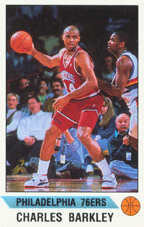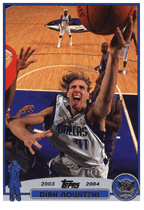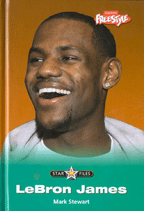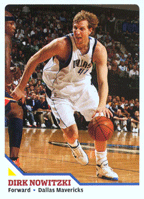| Dirk Nowitzki — Biography | |||||
| bio | facts | what they say | my say | ||
Getting labeled a franchise player in the NBA is a double-edged sword. It comes with great rewards but also with awesome responsibility. Dirk Nowitzki is one of the few players who has shouldered both—without being handed a ticket out of town. It took the German superstar more than a decade to bring a Big W to the Big D, but by any measure, it was worth the wait. To the delight of Mavericks fans, in 2011, Dirk crashed LeBron James’s NBA Finals coronation and stole the crown for himself. This is his story…
| |
GROWING UP
Dirk Werner Nowitzki was born on June 19, 1978 in Wurzburg, West Germany. (Click here for a complete listing of today's sports birthdays.) He was Helga and Jorg-Werner’s second child, being preceded by a sister named Silke. The ancient Bavarian city of Wurzberg had been almost completely destroyed by Allied bombing raids during World War II, but the historic buildings were reconstructed in the decades after the war, so Dirk grew up in a place that was at once old and new. Wurzberg was not a particularly well-known sports town, though one of Dirk’s contemporaries, Frank Baumann, became an international soccer star.
Dirk’s family, by contrast, was all about sports. Helga played on West Germany’s national basketball team in the 1960s and early 1970s. She also logged time as a pro in Europe. Jorg-Werner was a world-class team handball player. Dirk looked up to his parents and learned form them. His sister also provided inspiration. Silke was a first-division pro basketball player by the time she was 20.
Four years younger than his sibling, Dirk was also on the basketball fast-track. From an early age, he towered above other children his age, but he was freakishly coordinated thanks to impeccable genetics. Dirk was a standout in tennis and also dominated team handball games, taking after his dad. But it was inevitable that he find his way to the hardwood. In 1993, around the age of 15, he joined the local basketball club, DJK Wurzburg. Dirk suited up for the boys team, while Silke played for the women’s team.
Typically in Europe, young basketball players are taught the fundamentals with the assumption that they will be guards. Should they sprout in size, they retain those skills while also developing further to meet the demands of their new position. Because Dirk was so tall so young, his early coaches focused on the skills that would be needed by a center. Dirk’s parents were approached by Holger Geschwidner, a national team player who had some interesting ideas about coaching. He convinced the Nowitzkis to let him train their son. Geschwidner proceeded to turn Dirk into a shooting and passing genius. Part of the process involved getting him to learn a musical instrument and also to read voraciously. Soon Dirk had improved to the point that he was one of the top players in he country. Geschwidner said he could be one of the top players in the world—but it meant training even harder. Dirk said let’s do it.
By the age of 17, Dirk had become a member of the Wurzburg’s men’s team. In his second year, 1995–96, he earned a starting spot. A consistent scorer over the next three seasons, he led his club to winning records each year. After fulfilling his mandatory military obligation (a 10-month stint that ended just after his 20th birthday), Dirk seemed ready to take on the world. He stood 6–11 and was basically unguardable. In his final year with Wurzburg, he averaged 28.2 points per game and boosted the clubfrom the second division of the Bundesliga to the first.
At this point, several top European teams had their eye on Dirk, but he had his eye on the NBA. He had participated in a European exhibition tournament called the Nike Hoops Heroes Tour. Several NBA stars traveled abroad to take the floor against the top talent on the continent. Dirk abused All-Star Charles Barkley, who said afterwards that if Dirk wanted to play in the NBA to give him a call.
This would prove to be unnecessary. In the spring of 1998, Dirk was selected by Milwaukee with the sixth pick in the NBA draft. The Bucks didn’t have much interest in him, but they had arranged a deal involving the Mavericks, who loved Dirk. The complicated transaction also landed Steve Nash in Dallas. Coach Don Nelson engineered the remarkable trade, which added two future NBA MVPs to the roster.
Dirk’s first NBA season was delayed by a labor squabble. While the players and owners worked things out, he returned to play a few more games for Wurzburg. The league resumed in 1999 with a 50-game schedule. Dirk manned the power forward position for the Mavs and was regularly overpowered by veteran strongmen. Fans called him "IRK," because he had no D. He wasn’t that bad, but there was a point at which he became so frustrated that he considered returning to Germany.
ON THE RISE
Things turned around in Dirk’s second season. New owner Mark Cuban made sure the team had whatever it needed and the players could focus on their basketball. Dirk put the lessons he learned as a rookie to work and averaged 17.5 points and 6.5 rebounds a game. It was as a passer that he truly drew raves. His court awareness was superb for a 21-year-old and at times Nelson used Dirk as a “point-forward”—playing a role that team leader Michael Finley had previously perfected.
Dirk became a consistent 20-point scorer in 2000–01, the same season his close friend Nash ascended to the starting point guard role. Along with Finley, they made up Big D’s "Big Three." The result was 53 wins and a long-awaited playoff berth for the Mavs. In the best-of-five first round, against the Utah Jazz, Dallas dropped the first two games. The Mavericks tied the series on a pair of 33-point performances by Dirk. They took Game 5 to advance. Unfortunately, Dallas lost in the next round to San Antonio. Dirk provided one of the few highlights when he overcame the flu (and Tim Duncan) to score 42 in the team’s only win against the Spurs.
![]()
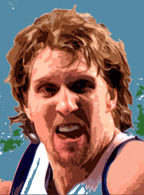
Convinced he had a player that could lead his team to the NBA Finals, Cuban inked Dirk to a six-year extension. He rewarded this confidence by continuing to improve in 2001–02 and making his first All-Star Game. The Mavs also improved, climbing to 57 wins. They easily disposed of Kevin Garnett and the Minnesota Timebrwolves in the opening round of the playoffs. The second round caused problems again. This time Sacramento beat Dallas. The Kings succeeded by using agile Hedo Turkgolu and burly Chris Webber to double-team Dirk. This strategy proved the key to a series that was ultimately decided by defensive stops.
In 2002–03, Dirk became a frequent 20-point, 10-rebound performer, logging double-doubles in half of histeam’s games. Overall, he averaged 25.1 points per contest. In the process, he became the first European player in NBA history to reach the 2,000-point plateau in a season. The Mavs boosted their win total to a franchise-record 60.
In the playoffs, the Mavs found themselves in a dramatic see-saw series with the Portland Trailblazers. In the waning moments of Game 7, Dirk nailed a clutch 3-pointer to ice the game. Dallas advanced to the second round, where they encountered the Kings again. This time the series went seven. In the deciding game, Dirk scored 30 and dominated the glass with 19 rebounds to lead the Mavs to a 112–99 win.
The team’s magical run ended in the Western Conference Finals when the Mavswent up against Duncan and the Spurs again. The first two games were classic confrontations between the big men, and NBA fans were captivated by the prospects of five more equally good games. Alas, in Game 3, a knee injury sent Dirk to the bench for the remainder of the series. Dallas put up a good fight but lost in six.
Heading into 2004–05, Dallas decided to relieve some of the scoring pressure from Dirk by trading for forwards Antawn Jamison and Antoine Walker. In the new configuration, Dirk acted as the Mavs’ de facto center, both on offense and defense. He bulked up over the summer for this new role, and his added muscle affected his quickness. Although he led the team in scoring, rebounding and blocks, Dallas was not as good with Dirk in the pivot. They won a respectable 52 games but were eliminated by their playoff rivals, the Kings, in the first round.
More changes followed in 2004–05. Nelson was replaced by assistant Avery Johnson. Nash was traded away. The center spot was filled by Erick Dampier, allowing Dirk to return to his old position. He responded by finishing behind Nash and Shaquille O’Neal in the MVP voting. He poured in 26.1 points per game and was included on the First Team All-NBA squad. It marked the first time a player who never attended a U.S. high school or college was among the league’s “Fab Five.”
The Mavs truly became “Dirk’s team” in 2005-06, after Dallas waived Finley. At age 27, he blossomed into a remarkable clutch player and deadly accurate shooter. There were few places on the court where Dirk couldn’t create a good shot. Given an open 3-pointer, he was money in the bank. Indeed, that winter, he won the 3-Point Shootout during the All-Star Game, topping Ray Allen and Gilbert Arenas. The Mavs equaled a franchise-best 60 wins and went into the playoffs as a dark horse to reach the NBA Finals.
Dirk carried the club throughout the postseason. Teaming with trash-talking guard Jason Terry and defensive specialist Josh Howard, he led the Mavs to a sweep of the Memphis Grizzlies, followed by a seven-game defeat of the Spurs. In the finale of that series, Dirk scored 35 points and pulled down 15 rebounds. In the Western Conference Finals against the Suns, Dirk seized control of the series in Game 5, snapping a 2–2 tie with 50 points. The Mavs won in six to advance to their first-ever NBA Finals.
There they faced Dwyane Wade, Shaquille O’Neal and the Miami Heat. In what was expected to be a close series, Dallas made things look easy, winning the first two games in Miami and building a seemingly insurmountable 15-point lead back in Dallas late in Game 3. Suddenly, however, it all came apart. Wade found another gear, and no one on the Mavs had an answer. Miami came back and won the next four games to rip the NBA title from Dirk’s grasp. The Mavs played without cohesion or confidence in the final three games, and Dirk was as much to blame as anyone.
Determined to make amends, Dirk enjoyed an MVP season in 2006–07. He shot over 50 percent from the field and led the Mavs to 67 victories. NBA fans were all but handing the championship trophy to Dallas when the clubsuffered one of the most shocking losses in postseason history. Entering the playoffs as the #1 seed, the Mavs were beaten in six games by the Golden State Warriors, a team that barely made the playoffs. The key to the series was Stephen Jackson’s defense on Dirk. The Golden State swingman’s quickness and strength made up for a dramatic height difference. In the final game, Dirk made just two baskets.
Two straight disappointments seemed to wear on Dirk in 2007–08. He was criticized as a superstar who didn’t have the heart to win it all. That label would dog him for the next several seasons.
The Mavs,meanwhile, were a good teamjust going though the motions at times. Dirk’s numbers were good as usual, but the team lost a lot of close games and finished as the seventh seed in the West. Not even the midseason addition of veteran Jason Kidd seemed to perk up Dallas. No one was shocked when the Maveswere beaten by New Orleans in the first round of the playoffs. The Hornets were a younger and hungrier team.
Dirk’s 11th NBA season was a nice bounce-back year. After a slow start, he and his teammates played well most of the year. He averaged over 25 points a game and played in his ninth All-Star Game. The Mavs faced the Spurs in the playoffs and upset them in five games. With San Antonio out of the way, Dallas fans began thinking this might be their year, but the Nuggets surprised them in the next round. Dirk played valiantly in the five-game loss, averaging nearly 35 points a game. BUt it was becoming clear that Dallas needed a better caliber of role players. Otherwise the money they were spending on Dirk and Kidd simply made no sense.
MAKING HIS MARK
Over the next two seasons, the Mavs found ways to improve their depth. They acquired veterans Shawn Marion, Tyson Chandler, Caron Butler, Brendan Haywood, DeShawn Stevenson and Peja Stojakovic. Terry became a high-scoring sixth man. Under Rick Carlisle, who replaced Johnson after the 2008 playoffs, the Mavs developed into a superb team. In 2009–10, Dallas finished with the best record in the Southwest Division but lost in the opening round of the playoffs to the Spurs. In 2010–11, the Mavericksfinished second in the conference, but they entered the postseason a far more confident team. Dirk had been injured during the year, and the Mavs struggled without him. When he came back, the club was invigorated.
Dallas had some nervous moments in the first round of the playoffs against the Trailblazers. The Mavs survived to win in six games, with Dirk leading the club in scoring in all four victories. He finished off Portland with a 33-point, 11-rebound performance.
Next up were the Lakers, who had just finished a grueling series with the Hornets. In Game 1, Dallas erased a 16-point deficit to beat Los Angeles, 96–94. The Lakers looked unsure of themselves the rest of the series, as the Mavs swept the defending champs in impressive fashion. The final game was an ugly 122–88 blowout.
The Western Conference Finals pitted the Mavs against the young Oklahoma City Thunder. Experience won out, as Dallas took the series in five games. The Mavs defended Kevin Durant well, while the Thunder had no answer for Dirk. In the opening game, they sent him to the foul line 24 times, and he made all 24 free throws to eclipse a record held by Paul Pierce. He finished with 48 points. Dirk also reached the 40-point plateau in the pivotal Game 4, which Dallas took on Oklahoma City’s homecourt, 112–105.
Back in the NBA Finals after a five-year absence, the Mavs had just two holdovers from the previous squad, Dirk and Terry. They faced the Heat and their old nemesis Wade. This time he was backed by Chris Bosh and LeBron James. In fact, the series was regarded by many as a coronation for "King James." However the experts noted that Dallas presented some complex match-up problems for Miami. If the Mavs could control one of the Heat’s two high-scoring stars and if Dirk created enough havoc, theyhad a puncher’s chance in the series.
| |
After dropping Game 1, Dallas faced a 15-point deficit in the fourth quarter of Game 2. The Mavs didn’t panic and clawed back. Dirk—playing with a damaged tendon in his left middle finger—hit the go-ahead 3-pointer in the final minute. With three seconds left, he made a twisting layup that gave Dallas its final two points in a 95–93 win.
The series moved to Dallas, where the Mavs dropped Game 3, 88–86. Dirk had a good look on the potential game-tying shot, but it clanked off the rim. The Mavs hung tough two nights later, eking out an 86–83 victory. Dirk was under the weather, playing with a 101-degree fever. In a thrilling see-saw battle, he dug down deep and scored 10-fourth quarter points, including the winning basket with 15 seconds left.
As the action switched back to Miami, the focus was now on James. Instead of seizing control of the series, he had faded into the background. Game 5 was a perfect example. James registered a triple-double, but he disappeared again at crunch time, scoring a mere two points in the fourth quarter. Once again, Dallas owned the final period, finishing the game on a 17–4 run to win 112–103. Dirk led all scorers with 29 points.
Now brimming with confidence, the Mavs returned to their home arena. They built a small lead in the first half of Game 6, and controlled Miami in the second half to win 105–95. Dirk had a miserable first half, but his teammates were raining three-pointers on the Heat. He recovered to finish with 21 points and 11 rebounds. After the final buzzer sounded, Dirk made a dash for the locker room. There he learned that he had been named MVP of the NBA Finals.
It took a unique player to bring a winner to Dallas, which is only fitting given the team’s unique owner. But does that mean that Dirk is truly one of a kind? European basketball coaches have already begun to tweak their training methods based on Dirk’s success, and up-and-coming big men are emulating him from childhood. Watching what emerges from this cauldron of basketball talent should be almost as interesting as seeing how Dirk finishes his NBA career.
One thing is certain: Dirk no longer has to toil under the tag of a great player who can’t win the big one. In fact, his sterling performance in the 2011 playoffs has elevated him to the company of NBA legends. That may be a heavy corwn to wear, but Dirk has proven that he won’t be pigeonholed by any label placed on him by his fans or by his critics.
DIRK THE PLAYER
Dirk came into the NBA with the skills to become an All-Star. He has developed beyond what many experts imagined he could. He has a smooth, strong, accurate shot launched at the optimal angle even when his body is not. Dirk can create an open shot or square up and nail wide-open jumpers. He can drive with either hand. His only weakness is his post-up game, but even that is average for his position. That being said, he has learned how to work against smaller, quicker defenders, who used to give him fits.
Only a handful of players Dirk’s size have ever passed as well. Unlike the Spurs and Tim Duncan, however, the Mavs do not typically run their offense through him. Fortunately he has been teamed with some good point guards during his years in Dallas, so he gets most of his assists starting from the wing.
Dirk’s defense is more than adequate given the minutes he logs. He is a good rebounder who uses the fundamentals to gain position and avoid foul trouble. As a team leader, he tends to motivate by example. When the Mavs lost to the Heat in the 2006 NBA Finals, many felt Dirk could have stepped up and done a better job to rally his teammates. That view is not without merit. But Dirk showed in 2011 that he has the fortititude to be a true leader.
| Dirk Nowitzki — Biography | |||||
| bio | facts | what they say | my say | ||
© Copyright 2011 Black Book Partners, LLC. All rights reserved.
